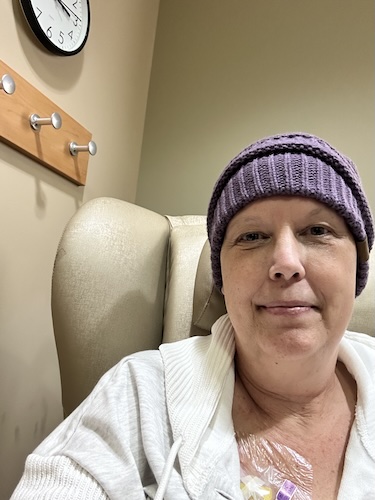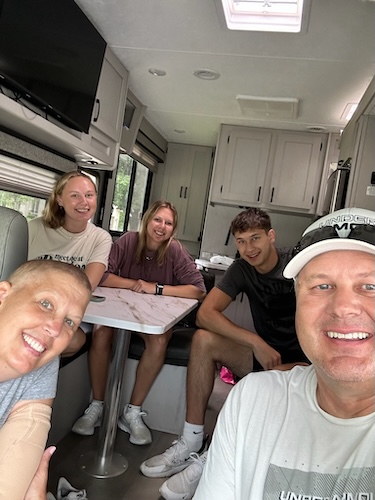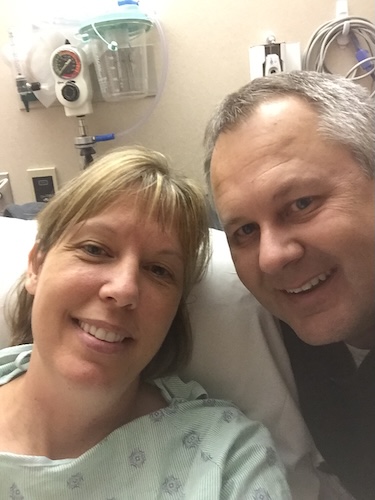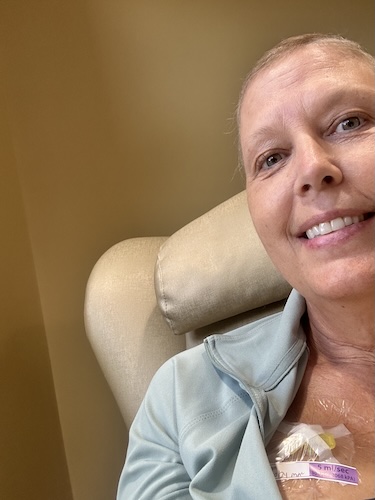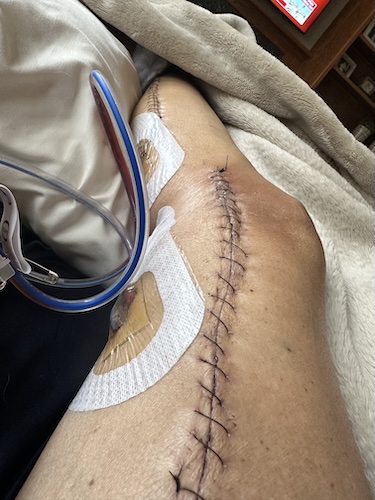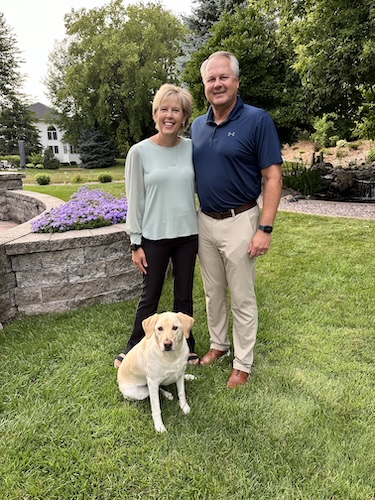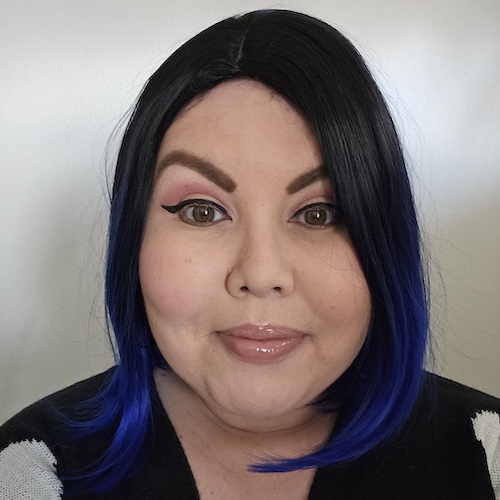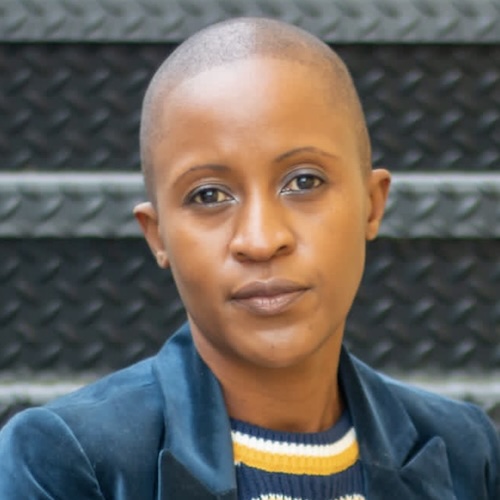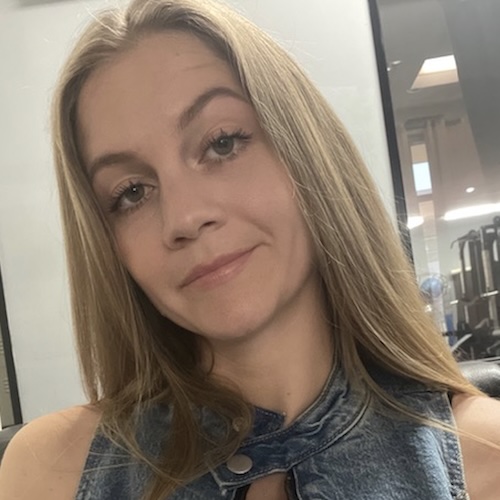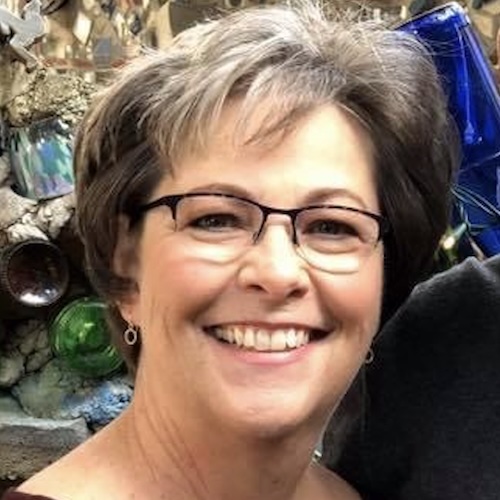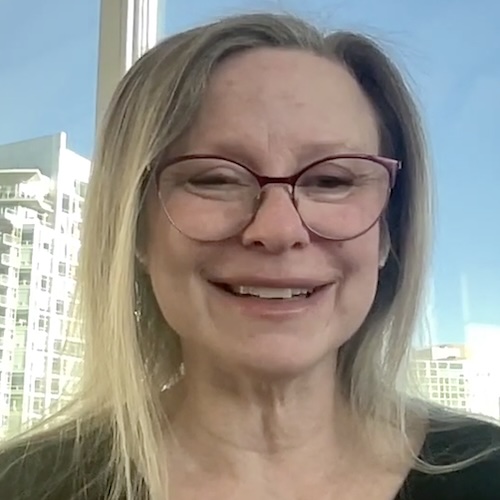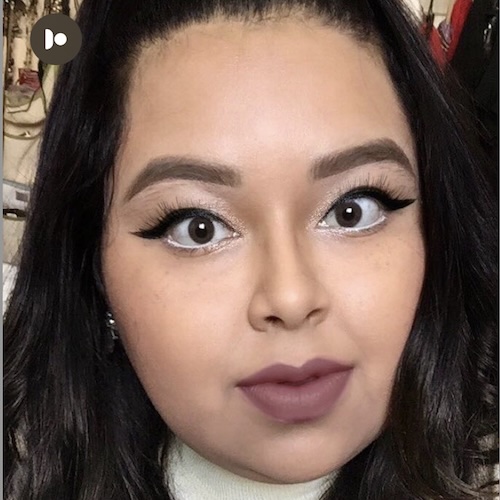I was Given 18 Months–5 Years Ago! Tammy’s Stage 4 Metastatic Breast Cancer Story
This is Tammy’s story about life with metastatic breast cancer. She opens up about how her life shifted dramatically because of her experience. One day, she was walking five miles, and the next, she was in a wheelchair because cancer had eaten through her femur.
Interviewed by: Nikki Murphy
Edited by: Chris Sanchez
Tammy first faced breast cancer in 2014, after a misdiagnosed lump turned out to be far more serious than expected. After surgery, chemotherapy, radiation, and hormone therapy, she carried on with her life. But in 2020, pain in her hip and leg led to a devastating diagnosis of metastatic breast cancer. She shares how hard it was to process the prognosis, especially when her first oncologist gave her only 18 months to live. Rather than accept that, she became her own best advocate. She sought six different opinions, learned about treatment lines, and found a medical team that listened to and supported her.

Throughout her experience, Tammy emphasizes the importance of self-advocacy. She explains how staying informed about treatment options, asking questions, and seeking second (or sixth) opinions have been life-giving choices. Each progression of her metastatic breast cancer led to new therapies, such as hormone therapies, and she highlights the urgent need for research and clinical trials. In fact, she’s a passionate supporter of clinical trials because the drug currently keeping her disease in check didn’t even exist three years ago. This, she says, is why funding research matters; not only to extend lives, but also to improve the quality of life for people living with stage 4 disease.
Tammy also offers her insights on the emotional side of living with metastatic breast cancer. She talks about the weight of thinking that every holiday, birthday, or family gathering might be her last. She crochets baby blankets for her future grandchildren, not knowing if she’ll be present when they’re born. Yet she embraces the present moment and encourages others to grant themselves grace. Her strong faith helps her stay grounded, and she clings to hope in all its forms. She looks forward to seeing her children get married, to keep sharing happy moments with her family, and to continue finding treatments that work.
Watch Tammy’s video above and read her interview transcript below.
- From walking five miles to being in a wheelchair overnight, Tammy’s stage 4 breast cancer story is one of resilience and hope
- Six second opinions and numerous treatments. Why she refuses to give up
- Learn why Tammy crochets baby blankets for grandkids she dreams of meeting
- Understand why the hardest part for Tammy is the fear that every special occasion could be her last
- See how hope, faith, and self-advocacy fuel her resolve
- Name: Tammy U.
- Diagnosis:
- ER-Positive HER2-Low Metastatic Breast Cancer
- Age at Diagnosis:
- Stage 2B: 42
- Stage 4: 49
- Staging:
- 2014: Stage 2B
- 2020: Stage 4
- Symptoms:
- Severe back pain
- Right hip pain
- Left leg pain
- Treatments:
- Surgeries: mastectomy, hip arthroplasty
- Chemotherapy
- Radiation therapy
- Hormone therapy
- Targeted therapies: CDK4/6 inhibitor, antibody-drug conjugate
This interview has been edited for clarity and length. This is not medical advice. Please consult with your healthcare provider to make informed treatment decisions.
The views and opinions expressed in this interview do not necessarily reflect those of The Patient Story.
- My name is Tammy
- My first experience with breast cancer was caught early, and by accident
- Years later, I started experiencing pain
- Learning that my cancer returned was devastating, because it’s incurable
- My oncologist told me I was out of treatment options
- What my current treatment looks like, and the plan moving forward
- What people don’t understand about stage 4 breast cancer
- It’s hard not to think that certain moments and events could be my last
- My hope for the future is that manageable treatments improve the quality of life for stage 4 patients
My name is Tammy
I was diagnosed with early-stage breast cancer in 2014 and metastatic breast cancer in 2020.
My first experience with breast cancer was caught early, and by accident
I went in for my very first mammogram at the age of 40. They found a calcification or several calcifications that they were going to watch at that time. So they had me doing a mammogram every six months thereafter.
Two years later, after having four mammograms, they told me I was clear and I could go back to yearly mammograms. That was in June. I had found a lump in my left breast shortly before that June mammogram and brought it up. They said the mammogram was clear. “There wasn’t anything there, nothing to worry about.” And I should just get on with life. And so I did.
As luck had it or not, I tore my biceps tendon in January and was going to have my shoulder done, and I had to have a pre-op physical. So I went to my primary care doc and I said, “Hey, I’ve got this lump.” It was protruding through the skin. She took a look at it and looked at the mammogram, and she said, “You know, it’s just a cyst. Just have that drained if it’s bothering you.” So in February of 2014, I went in for what I thought was just a cyst drainage. I was joking with the surgeon and how he was going to make the scar so no one would ever be able to tell I had had surgery.
I was put under. When I woke up, I saw my husband and the surgeon in the hallway. The anesthesiologist was holding my hand, and I knew immediately before they said a word that it was not a benign cyst. So that spiraled into having a mastectomy, chemotherapy, radiation, and hormone therapy, which I was going to be on for ten years. And I went on with life.
Years later, I started experiencing pain
In 2019, I was having right hip pain. They did an X-ray and sent me to physical therapy, and said that it wasn’t anything.
In 2020, we relocated to another part of Wisconsin, and I had to establish care with a new doctor, which I did. I was having a lot of knee pain when I would run. It was during COVID, and there wasn’t much to do but run. I chalked the pain up to that.
I saw my primary care provider for it. She did an X-ray. She said I just needed some physical therapy. I was doing that for about six weeks, wasn’t making any progress, and eventually I just stopped going. And God bless my physical therapist, he called me one afternoon and said, “Hey, why aren’t you coming anymore?” And I said, “No offense, you’re a wonderful person, but you’re not helping me one bit, and I’m not going to waste my time anymore.” He said, “Let’s have you see one of our sports medicine doctors. Maybe they’ll have some insight I don’t have.”
So I met with one of those sports doctors, and he said, “Oh, this is simple. You have a torn meniscus, and we’re going to get in there. We’ll schedule it for surgery, and we’ll clean it up. You’ll be back running in six weeks. But first, we need to do an MRI.”
So they did the MRI. I didn’t even make it home before he called me. He said, “I don’t know how to tell you this because I deal with torn ACLs. That’s the worst news I’ve given people. But there’s something really wrong with your leg and the bone in your leg and your femur. Part of the knee. I don’t know what this is, but it’s way above what I see.”
I was referred to oncology then. A biopsy was done, and it was found that it was breast cancer that had eaten through my femur.
So I went from walking five miles one day to being confined to a wheelchair the next, for fear that it would fracture if I stepped down the wrong way. A PET scan later revealed that the right hip pain that I was complaining about was due to lesions on my right hip, and the L3, which was a benign issue, had completely fractured from cancer.
Learning that my cancer returned was devastating, because it’s incurable
Statistics for metastatic disease online through Doctor Google are very depressing. When I met with my oncologist and he told me that, at best, I could hope to live 18 more months, that was very hard to hear.
I immediately had my kids come home. My daughter who was a freshman in college, my oldest daughter, and my son who was living here. I sat them down with my husband, and we told them in person.
Honestly, death — that’s where I thought I was headed. And then there was a lot of anger that there were things missed along the way, and we were trying to process through how that happened.
I had no family history of cancer and no risk factors for it. I had the genetic testing done. And at that point, in 2014, I only qualified for the testing because of my age. But I didn’t carry any of the genes that you can see in breast cancer. I had genetic testing done again, not too long ago, because there’s so much more that they test for now than they did in 2014. And, by their standards, I still have zero risk of cancer.
My oncologist told me I was out of treatment options
My son was a sophomore in high school. I asked if I would see him graduate, and was told that that was highly unlikely.
I took the second opinion thing to the extreme. I got six. I wanted to make sure that I was completely comfortable with the path I was going to be on moving forward. So that’s kind of a standing joke. “Tammy doesn’t get a second opinion. She gets six second opinions.”
After talking to people and just doing my own advocacy for myself, I decided I needed to part ways with that oncologist. I didn’t feel that we were on the same page. And I also knew that there were other options for me. So I underwent a full right hip replacement. Stayed on the targeted therapy drug I was on for another full year under the guidance or the recommendation of my new oncologist. When that stopped working, we moved on to an oral chemotherapy drug, and I remained on that for a full year.
And then I had another progression, and was started on another targeted [00:16:30:00] therapy, an antibody drug conjugate, which was administered through an IV port. I had that treatment every three weeks. That started in April, and by the end of July, my scan showed no evidence of active disease.
I continued the same treatment until December, and then I stopped, because I was having my left hip replaced due to the cancer and the radiation, and all the damage that that caused. I had a series of failed surgeries for something that was supposed to be very simple, to the point where one of my doctors thought that I was going to have to amputate the leg at some point because of it, but I still have my leg. Then I resumed taking the same antibody-drug conjugate in July when my numbers started to creep up again. I’ve been on that ever since, and they’ve dropped significantly.
So the hope is that we’ll get back to no evidence of active disease in the next short while.
What my current treatment looks like, and the plan moving forward
Every 21 days, I have treatments on Tuesdays and Fridays. I go in and I get a white blood cell booster so that my white blood cell count will allow me to have treatment on Tuesdays.
I am fortunate that my side effects are manageable. I deal with the usual ones: hair loss, fatigue, and nausea. But I find them acceptable. This is what I have to do to stay alive. It’s just kind of a repetitive cycle. And you just hope it works for a long time to come.
Every time I’ve had a progression with the oncologist I’ve been seeing for the last several years, the first thing we do is look into clinical trials and my eligibility for those. There are some questions as to whether my estrogen receptor-positive cancer has mutated to a triple negative, and some biopsies have indicated it’s a possibility. That does kind of throw a little bit of a wrench in things. But we always look for clinical trials first before deciding on a treatment. So obviously, I’m a big proponent of those. And I hold out hope that I’ll be able to participate at some point. The drug that I’m on now wasn’t available to me three years ago. It’s a game-changer.
What people don’t understand about stage 4 breast cancer
Well, when I had hair and I didn’t look sick, or even now when I put a wig on and I go out, I think people fail to realize that I’m still in treatment, that I still struggle.
I was always go, go, go. I was the mom who was doing everything, who was involved in everything. Now, especially because I’m still not walking, I depend on people for everything in my day. And that’s very difficult. But stage 4, in general, when people see you, you get asked all the time, “Oh, when are you done with treatment?” People do not understand that you’re never going to be done.
They also don’t understand that you’re not going to die from stage 2 breast cancer. You are more likely to die from stage 4. And any research that we can do for stage 4 is going to benefit those early stages. But the statistics of living with stage 4 metastatic disease are daunting, honestly. I just passed my five-year mark from my official diagnosis, although obviously I was dealing with it longer than that, and I’ve lost so many people I’ve come to know in the metastatic community, and I just don’t think people realize that.
Somebody said, “What do you mean? You have breast cancer in your bones?” There’s just a lack of awareness, I think.
It’s hard not to think that certain moments and events could be my last
I tell people now, when I meet them after they’re first diagnosed, that they just have to grant themselves grace.
When I was initially diagnosed, I kept thinking, especially in that first year, “This is the last time I’m going to have a vacation with my family,” or, “This is the last time we’re going to celebrate a holiday or a birthday.” That was really, really hard for me, because every event seemed like it was my last one.
I specifically remember one time that my daughters were home and I had baked a cake. I had gone upstairs to my room to change. I came down, and they had frosted the cake for me, and it was the worst job of frosting a cake I had ever seen. I burst into tears and said, “I haven’t even taught you how to frost a cake. What else haven’t I taught you that I’m not going to be here to teach you in the future?”
So that mindset was probably the hardest part. You just have to learn to accept the moment that you’re in. Try to remain as positive as you can. I have a very strong faith that guides me in everything I do.
For me, the physical limitations are probably the greatest challenge. Because your quality of life always has to come first, and being pushed around in a wheelchair by your son or whoever is just difficult.
I can’t do things myself that I would want to do. I still hold out hope that someday, I will again.
My hope for the future is that manageable treatments improve the quality of life for stage 4 patients
Hope is my favorite word.
You just can’t give up hoping. I had listened to that doctor I saw early on, if I had believed him when he said, “I’m sorry, you’ve got 18 months to live,” I wouldn’t still be here. I don’t let people take away my hope.
I understand that hope looks different for everybody. One of my daughters just got engaged. She’ll be getting married next year. I never thought that I’d be here to see that day. Now I hope I’m here to see the next one get married, which will be the year after that.
So, you know, it’s just holding out hope for whatever that looks like for you in that moment. And just not letting go of that.

Inspired by Tammy's story?
Share your story, too!
More Metastatic Breast Cancer Stories
Deb O., Breast Cancer (De Novo Triple Positive and ER+ HER-)
Symptoms: First instance: appearance of lump that later on increased in size, orange peel-like skin around inverted nipple, persistent ache under right arm; second instance: appearance of lump
Treatments: First instance: chemotherapy, targeted therapy, hormone therapy; second instance: surgery (mastectomy), chemotherapy, radiation therapy, CDK 4/6 inhibitor
Tammy U., Metastatic Breast Cancer, Stage 4
Symptoms: Severe back pain, right hip pain, left leg pain
Treatments: Surgeries (mastectomy, hip arthroplasty), chemotherapy, radiation therapy, hormone therapy, targeted therapies (CDK4/6 inhibitor, antibody-drug conjugate)
Nicole B., Triple-Negative Metastatic Breast Cancer, Stage 4 (Metastatic)
Symptoms: Appearance of lumps in breast and liver, electric shock-like sensations in breast, fatigue
Treatments: Chemotherapy, surgeries (installation of chemotherapy port, mastectomy with flat aesthetic closure), targeted therapy (antibody-drug conjugate), hyperbaric oxygen therapy, lymphatic drainage
Dalitso N., IDC, Stage 4, HER+
Symptoms: Appearance of large tumor in left breast, severe back and body pain
Treatments: Surgery (hysterectomy), vertebroplasty, radiation therapy, hormone therapy, clinical trial
Marissa T., ILC, Stage 4, BRCA2+
Symptoms: Appearance of lump in right breast, significant fatigue, hot flashes at night, leg restlessness leading to sudden, unexpected leg muscle cramps
Treatments: Chemotherapy, hormone therapy, PARP inhibitor, integrative medicine
Janice C., Triple-Negative Metastatic Breast Cancer, Stage 4
Symptoms: Appearance of lump in left breast near sternum, fatigue, bone and joint pain
Treatments: Surgery (lumpectomy), radiation therapy (brachytherapy), chemotherapy
Dana S., IDC, Stage 4 (Metastatic)
Symptom: Appearance of large lump in left armpit
Treatments: Targeted therapy, hormone blockers, bone infusions
Maria S., Breast Cancer, Stage 4
Symptoms: Intermittent but severe pain including a burning sensation on the side of the breast, appearance of a cyst and a lump, abnormally warm and pink-colored breast, nipple inversion, strangely liquid menstrual periods, unusual underarm odor, darkening and dimpling of the nipple, severe fatigue, night sweats
Treatments: Chemotherapy, surgeries (mastectomy, lymphadenectomy), radiation therapy, targeted therapy
- 1
- 2
